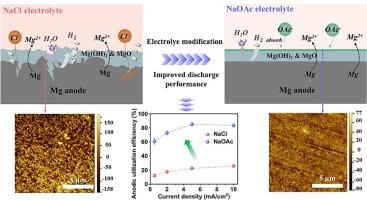使用醋酸钠改善镁空气电池的腐蚀行为和放电性能
IF 6.9
2区 材料科学
Q2 CHEMISTRY, PHYSICAL
引用次数: 0
摘要
介绍了镁空气电池在纯镁阳极下的放电行为,强调了在乙酸钠(NaOAc)电解液中阳极利用率和比容量比在氯化钠(NaCl)电解液中有所提高。此外,在半电池试验中,当电流密度增加时,放电电位仅略有降低。NaOAc电解质中醋酸离子的侵蚀性较低,有利于形成均匀的保护性氧化层,而NaCl电解质中的氯离子则会促进氧化物的击穿和局部腐蚀。NaOAc电解质中形成的保护层限制了Mg的降解,降低了H2的析出速率,提高了放电性能。利用飞行时间二次离子质谱(ToF-SIMS)、x射线光电子能谱(XPS)和原子力显微镜(AFM)对NaOAc中纯Mg阳极的表面进行了表征,发现其表面形成了较致密的腐蚀层,有利于提高阳极的耐蚀性和阳极利用率。采用纯Mg、Mg-0.2 ca和AZ31合金进行的全电池放电试验表明,在NaOAc电解液中阳极利用率和比能均有所提高,特别是Mg-0.2 ca,在2 mA/cm2下阳极利用率可达2066 Wh/kg。这些结果表明,NaOAc是一种很有前途的电解质,可以改善不同镁基负极材料的镁空气电池的性能。本文章由计算机程序翻译,如有差异,请以英文原文为准。


Insights into corrosion behaviour and discharge performance improvement in Mg-Air batteries using sodium acetate
The discharge behaviour of Mg-air batteries with pure Mg anodes is presented, highlighting the improved anodic utilization efficiency and specific capacity in sodium acetate (NaOAc) electrolyte over sodium chloride (NaCl) electrolyte. Moreover, only a modest reduction in discharge potential was noted at increased current densities in half-cell tests. NaOAc electrolyte, containting less aggressive acetate ions, enables the formation of a homogeneous and protective oxide layer, in contrast to the chloride ions in NaCl electrolyte, which promote oxide breakdown and localized corrosion. The protective layer formed in NaOAc electrolyte limits Mg degradation, reduces H2 evolution rate, and enhances discharge performance. The surface characterizations by Time-of-Flight Secondary Ion Mass Spectrometry (ToF-SIMS), X-ray Photoelectron Spectroscopy (XPS) and Atomic Force Microscopy (AFM) reveal a denser corrosion layer formed on the surface of pure Mg anode in the NaOAc electrolyte, contributing to improved corrosion resistance and increased anodic utilization efficiency. Full-cell discharge tests using pure Mg, Mg-0.2Ca, and AZ31 alloy show that the anodic utilization efficiency and specific energy are improved in NaOAc electrolyte, particularly for Mg-0.2Ca, with energy density of 2066 Wh/kg at 2 mA/cm2. These findings suggest that NaOAc is a promising electrolyte for improving the performance of Mg-air batteries for different Mg-based anode materials.
求助全文
通过发布文献求助,成功后即可免费获取论文全文。
去求助
来源期刊

Applied Surface Science
工程技术-材料科学:膜
CiteScore
12.50
自引率
7.50%
发文量
3393
审稿时长
67 days
期刊介绍:
Applied Surface Science covers topics contributing to a better understanding of surfaces, interfaces, nanostructures and their applications. The journal is concerned with scientific research on the atomic and molecular level of material properties determined with specific surface analytical techniques and/or computational methods, as well as the processing of such structures.
 求助内容:
求助内容: 应助结果提醒方式:
应助结果提醒方式:


